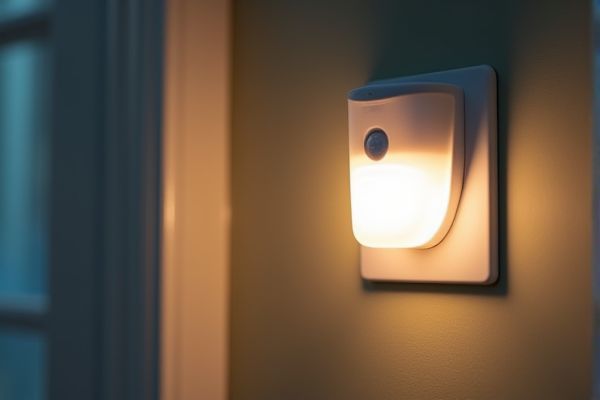
Motion sensor lights automatically illuminate spaces when movement is detected, enhancing convenience and energy efficiency by eliminating the need for manual operation. You can explore the pros and cons of motion sensor lights versus manual switches in the rest of this article to determine the best option for your lighting needs.
Table of Comparison
| Feature | Motion Sensor Light | Manual Switch |
|---|---|---|
| Operation | Automatically detects motion to turn on/off | Requires manual toggling to operate |
| Energy Efficiency | High - saves energy by activating only when needed | Low - often left on unintentionally |
| Convenience | Hands-free and automatic | Requires physical action |
| Installation | More complex - requires sensor wiring and placement | Simple - standard electrical installation |
| Cost | Higher initial cost due to sensor technology | Lower upfront cost |
| Control | Limited user control, automatic activation | Full manual control over on/off |
| Maintenance | Sensor cleaning and occasional recalibration needed | Minimal maintenance |
Introduction to Motion Sensor Lights vs Manual Switches
Motion sensor lights automatically detect movement and illuminate your space without the need for manual activation, enhancing convenience and energy efficiency. Manual switches require you to physically turn the light on or off, offering direct control but potentially leading to unnecessary energy consumption. Choosing between motion sensor lights and manual switches depends on your preference for automation versus hands-on operation in lighting control.
How Motion Sensor Lights Work
Motion sensor lights use infrared technology to detect body heat or movement within a specific range, automatically turning on when motion is sensed and switching off after a preset time without activity. Unlike manual switches that require your physical interaction to operate, motion sensor lights offer hands-free convenience, improving energy efficiency by only illuminating spaces when needed. Your home or workspace becomes safer and more eco-friendly with the timely response of these sensors to actual presence.
Functionality of Manual Switches
Manual switches provide direct control over lighting by allowing users to turn lights on or off at their discretion, ensuring precise operation without relying on sensors or timers. They are simple in design, cost-effective, and require no power source beyond the light itself. This functionality makes manual switches highly reliable and easy to maintain, particularly in settings where intentional lighting control is preferred.
Energy Efficiency Comparison
Motion sensor lights significantly enhance energy efficiency by activating only when movement is detected, reducing unnecessary electricity consumption compared to manual switches, which rely on user diligence to turn lights off. Studies show that motion sensor systems can reduce lighting energy use by up to 30-50% in residential and commercial settings. Manual switches potentially lead to prolonged lighting periods and increased energy waste, especially in frequently unoccupied areas.
Installation and Setup Requirements
Motion sensor lights require a more complex installation process involving wiring to sensors and power sources, often necessitating professional expertise to ensure proper placement and functionality. Manual switch setups are straightforward, typically involving simple wiring to standard switches with minimal technical knowledge needed. The initial setup time for motion sensor lights is generally longer due to calibration and sensor adjustment, whereas manual switches allow immediate use after installation.
User Convenience and Accessibility
Motion sensor lights enhance user convenience by automatically illuminating spaces without the need for physical interaction, making them ideal for hands-free access and improving safety in low-light conditions. Manual switches, while straightforward, require deliberate action and may pose challenges for individuals with mobility issues or when hands are occupied. Your choice between these options affects accessibility and ease of use, especially in environments where automatic lighting can streamline daily routines.
Cost Analysis: Initial and Long-Term
Motion sensor lights generally have higher initial costs due to advanced sensors and installation requirements compared to manual switches, which are simpler and cheaper to install. Over time, motion sensor lights offer savings by reducing energy consumption through automatic operation, whereas manual switches rely on user habits, potentially leading to higher electricity bills. Maintenance costs for motion sensor systems may be slightly higher due to sensor calibration and replacements, but the energy cost reduction often outweighs these expenses in the long term.
Security and Safety Benefits
Motion sensor lights enhance security by automatically illuminating dark areas when movement is detected, deterring potential intruders and reducing the risk of accidents caused by poor visibility. Manual switches rely on occupant vigilance, which can lead to delays in turning lights on, increasing the chances of trips or falls in dim environments. Your safety is significantly improved with motion sensor lights as they provide consistent, hands-free lighting in critical moments.
Maintenance and Durability
Motion sensor lights offer low maintenance with fewer mechanical components prone to wear, while manual switches may require frequent replacements due to physical usage. The durability of motion sensor lights is enhanced by their sealed electronic sensors that resist dust and moisture, compared to manual switches which often suffer from contact wear and degradation over time. Frequent testing and occasional battery replacements in motion sensors ensure consistent performance, whereas manual switches rely on simple, robust designs but face increased failure rates from repeated physical interaction.
Choosing the Right Option for Your Needs
Motion sensor lights offer hands-free convenience by detecting movement and automatically illuminating spaces, ideal for areas like hallways or garages where quick access to light enhances safety. Manual switches provide direct control, allowing you to turn lights on or off at your discretion, which suits environments where precise lighting preferences or prolonged illumination are necessary. Evaluating your specific usage patterns, energy efficiency goals, and convenience requirements will help you decide whether a motion sensor light or manual switch best fits your needs.
 homyna.com
homyna.com